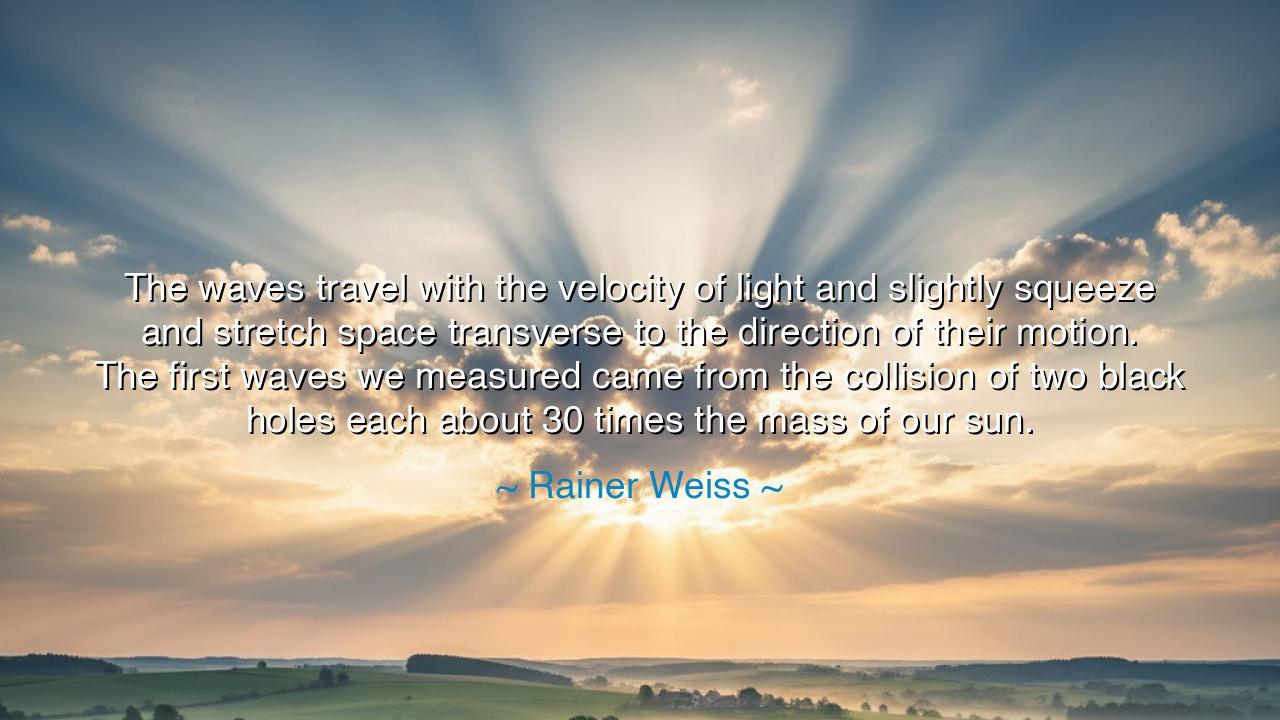
The waves travel with the velocity of light and slightly squeeze
The waves travel with the velocity of light and slightly squeeze and stretch space transverse to the direction of their motion. The first waves we measured came from the collision of two black holes each about 30 times the mass of our sun.






Hear the words of Rainer Weiss, seeker of the unseen and listener of the cosmos, who declared: “The waves travel with the velocity of light and slightly squeeze and stretch space transverse to the direction of their motion. The first waves we measured came from the collision of two black holes each about 30 times the mass of our sun.” These words, though born in the language of science, echo with the grandeur of myth. For they speak not only of equations and instruments, but of the trembling of the universe itself, the ripples of creation that whisper across eternity.
What are these waves but the very breath of spacetime, the music of the cosmos that Einstein once foresaw? For a hundred years they remained a prophecy, a vision written in mathematics but unheard by human ears. Yet Weiss, with patience and devotion, built the tools to listen. And when at last the signal came—faint, delicate, a ripple smaller than the width of a proton—it was the voice of two black holes, locked in their final dance, colliding in darkness a billion years ago. Their violent union shook the fabric of space, and Earth, tiny and fragile, felt the echo.
This discovery was not merely a triumph of physics, but a revelation of humanity’s power to listen to the universe itself. For thousands of years, men looked upward and saw only the light of stars, believing that light was the only messenger across the void. But Weiss and his companions opened a new sense, an ear to spacetime itself. No longer do we only see the heavens—we now hear them, in the rolling thunder of invisible waves. This is as profound as when Galileo first lifted his telescope, expanding the horizon of what could be known.
History reminds us that such breakthroughs come not from comfort, but from persistence against doubt. Galileo, who dared to say the Earth was not the center, was mocked and silenced. Yet his truth endured. So too, Weiss labored through decades when many dismissed gravitational waves as unmeasurable, a dream beyond reach. He built LIGO, the great observatory, with mirrors and lasers stretched across miles, attuned to the whispers of the universe. His faith in the unseen proved true, and what was once theory became reality.
The collision of black holes is not merely an astrophysical event; it is a symbol of power, transformation, and rebirth. Two giants, each thirty times the mass of our Sun, collided and merged, releasing more energy in an instant than all the stars in the visible universe. From their destruction came waves that traveled across the void for a billion years, reaching us as a faint vibration in the fabric of existence. This reminds us that even in the most violent endings, there is a message, a legacy, a ripple that endures.
The lesson, O seeker, is clear: do not believe that silence means absence. The universe is filled with voices waiting for ears that are patient enough to hear. What seems impossible today may be tomorrow’s revelation. Just as Weiss listened for the whispers of spacetime, so must you listen for the quiet truths in your own life—the hidden patterns, the subtle ripples, the signs of deeper reality. For often the most powerful truths come not with thunder, but with faint vibrations that only the attentive will notice.
And in your own labor, remember this: greatness requires perseverance against doubt. For decades, Weiss worked on a dream that many thought folly. Yet because he endured, humanity gained a new way of knowing. Let his story remind you that your struggles, too, may one day bear fruit beyond imagination. Do not falter when mocked, do not abandon your dream when the world calls it impossible. The waves of your effort may one day travel far beyond your life, shaping destinies you will never see.
So let Weiss’s words resound as a hymn to discovery: the universe itself is alive with waves, stretching and squeezing the very fabric of reality. To listen to them is to step closer to creation’s heart. And so, be patient, be faithful, and be bold—for the ripples of your life, like the ripples of black holes, may travel farther than you can ever dream.






AAdministratorAdministrator
Welcome, honored guests. Please leave a comment, we will respond soon